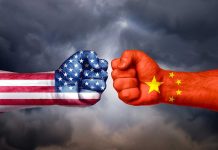
Trump threatens 100% tariffs on BRICS nations if they abandon the U.S. dollar, potentially reshaping global trade dynamics.
At a Glance
- Trump proposes 100% tariffs on BRICS countries moving away from the U.S. dollar
- BRICS expanded in 2023 to include Egypt, Ethiopia, Iran, Saudi Arabia, and UAE
- Trump demands commitment from BRICS not to create or support a new currency
- China-U.S. trade reached $758.4 billion in 2022, highlighting economic interdependence
- Proposed tariffs align with Trump’s “America First” economic policy
Trump’s Bold Move to Protect U.S. Dollar Dominance
In a decisive stance to maintain the U.S. dollar’s global supremacy, President-elect Donald Trump has proposed a sweeping 100% tariff on BRICS countries if they attempt to move away from using the dollar in international trade. This aggressive economic strategy targets the intergovernmental organization consisting of Brazil, Russia, India, China, and South Africa, established in 2006 to boost investment opportunities and global influence.
Trump’s proposal comes as a direct response to whispers of BRICS exploring alternatives to the U.S. dollar, a move that could potentially threaten America’s economic hegemony. The President-elect’s stance is clear: any attempt to replace the dollar will result in severe economic consequences.
BRICS Expansion and Dollar Alternatives
The BRICS alliance has grown significantly since its inception, with the addition of Egypt, Ethiopia, Iran, Saudi Arabia, and the United Arab Emirates in 2023. This expansion has raised concerns about the group’s potential to challenge the U.S. dollar’s dominance in global trade. While some members, particularly Russia, have been vocal about exploring alternative currencies, economic powerhouses like China and India remain heavily invested in U.S. trade.
“The idea that the BRICS Countries are trying to move away from the Dollar while we stand by and watch is OVER. We require a commitment from these Countries that they will neither create a new BRICS Currency, nor back any other Currency to replace the mighty U.S. Dollar or, they will face 100% Tariffs, and should expect to say goodbye to selling into the wonderful U.S. Economy. They can go find another ‘sucker!'” – Trump Source
Trump’s stern warning underscores the significant economic ties between the U.S. and BRICS nations. In 2022, trade between China and the U.S. reached a staggering $758.4 billion, while U.S.-India trade amounted to approximately $191.4 billion. These figures highlight the potential impact of Trump’s proposed tariffs on global trade dynamics.
Will the Trump 100% tariff on BRICS countries backing alternatives to the U.S. dollar be effective?https://t.co/R4LFw7N6wA
— Gigi B (@GBallarani) November 30, 2024
“America First” and Global Trade Reshaping
Trump’s proposed 100% tariff on BRICS countries aligns with his broader “America First” economic policy, which aims to prioritize U.S. interests in global trade. This approach resonated with voters during his previous electoral success, partly due to his promise to impose high tariffs on foreign imports, including a proposed 60% tariff on Chinese goods.
“Trump’s recent electoral triumph was heavily fortified by his promise to impose harsh tariffs on foreign imports to the US, advocating for an aggressive 60% tariff on Chinese goods” – Stephen Innes Source
The potential implementation of these tariffs could have far-reaching consequences. While designed to protect U.S. economic interests, a 100% tariff on BRICS countries could lead to increased costs for member nations, potentially raise U.S. inflation, and significantly disrupt global trade patterns. Trump’s assertive stance sends a clear message: any attempt by BRICS to replace the U.S. dollar in international trade would result in losing access to the lucrative U.S. market.
Trump warned BRICS nations that he would require commitments that they would not move to create a new currency as an alternative to using the US dollar and repeated threats to levy a 100% tariff https://t.co/rHMgDG5N8G via @stephaniealai
— Stuart Wallace (@StuartLWallace) December 2, 2024
Implications for Global Economic Order
As the world watches these developments unfold, the potential for a significant shift in the global economic order looms large. Trump’s proposed tariffs and his uncompromising approach to maintaining U.S. dollar dominance could set the stage for a contentious start to his potential future administration.
The proposed 100% tariff on BRICS countries serves as a stark reminder of the complex and often tense relationships that define international trade. As nations like China and India continue to grow in economic power and influence, the U.S. faces increasing challenges to its long-held position of economic dominance. Trump’s aggressive stance may be seen as a necessary step to protect American interests, or it could potentially accelerate the very de-dollarization process it aims to prevent. Only time will tell how this bold move will reshape the landscape of global trade and economic alliances.






















